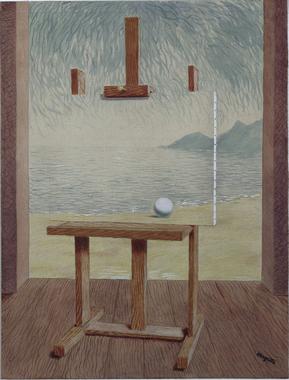
Human Condition - Analysis
By Thomas
Human Condition or La Condition Humaine is a series of surrealist paintings by 20th century Belgian artist Rene Magritte. The works were painted throughout the mid 1930s and the early 1940s, and were painted with oil on a canvas sized 100cm by 81cm. Initially an impressionist, when Magritte transferred to surrealist art, his style also carried over. This is clearly exhibited in Human Condition, where Magritte paints with impressionistic qualities.
The 1945 Human Condition like most others in the collection were set in a house overlooking nature. In this case we are set in what looks to be a beach house that opens to a beach with a blue sky and mountains in the distance. The brush strokes are fluid yet determined giving a mixture of impressionistic and realistic qualities. The piece is focused on an easel with a canvas that hides a portion of the landscape from the viewer, but at the same time reimagining it on the canvas in the same style as the rest of the scene, making it seem perfectly natural if not for the outlines of the canvas and the easel.
The idea that Magritte was implying, in my opinion, is that we cannot always believe what we see and the idea or object that is most important is the one that is mostly likely to be hidden. It is human nature to try to uncover what is hidden from us, and this painting is a perfect example for when people view it, most will only wonder what is behind the easel rather than contemplate on what is shown to us. Another point is how the truth can be hidden from us, especially in the world we live in today with bias media and corrupt governments. The simplicity of the scene with its peaceful nature and general calmness may trick us when the reality may be the complete opposite. In Human Condition, Magritte combines great artistic skill while presenting a deeply philosophical, underlying message, creating surrealist art at its finest.
good analysis
ReplyDelete